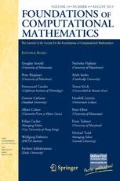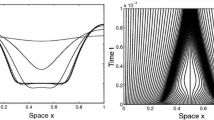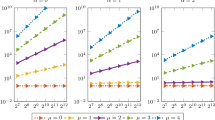Abstract
We consider generalized linear transient advection-diffusion problems for differential forms on a bounded domain in ℝd. We provide comprehensive a priori convergence estimates for their spatiotemporal discretization by means of a first-order in time semi-Lagrangian approach combined with a discontinuous Galerkin method. Under rather weak assumptions on the velocity underlying the advection we establish an asymptotic L 2-estimate of order \(O(\tau+h^{r}+h^{r+1}\tau^{-\frac{1}{2}}+\tau^{\frac{1}{2}})\), where h is the spatial meshwidth, τ denotes the time step, and r is the polynomial degree of the forms used as trial functions. This estimate can be improved considerably in a variety of special settings.


Similar content being viewed by others
Notes
When we say that a constant is independent of h, we mean that it may only depend on the shape regularity of the mesh cells, but not on their size.
References
S. Agmon, Lectures on Elliptic Boundary Value Problems, Van Nostrand, Princeton, Toronto (1965).
T. Arbogast, W.H. Wang, Convergence of a fully conservative volume corrected characteristic method for transport problems, SIAM J. Numer. Anal. 48(3), 797–823 (2010).
D.N. Arnold, An interior penalty finite element method with discontinuous elements, SIAM J. Numer. Anal. 19(4), 742–760 (1982).
D.N. Arnold, F. Brezzi, B. Cockburn, L.D. Marini, Unified analysis of discontinuous Galerkin methods for elliptic problems, SIAM J. Numer. Anal. 39(5), 1749–1779 (2001/02).
D.N. Arnold, R.S. Falk, R. Winther, Finite element exterior calculus, homological techniques, and applications, Acta Numer. 15, 1–155 (2006).
D.N. Arnold, R.S. Falk, R. Winther, Finite element exterior calculus: From Hodge theory to numerical stability, Bull. Amer. Math. Soc. (N.S.) 47(2), 281–354 (2010).
J. Baranger, A. Machmoum, A “natural” norm for the method of characteristics using discontinuous finite elements: 2D and 3D case, Math. Model. Numer. Anal. 33(6), 1223–1240 (1999).
M. Bause, P. Knabner, Uniform error analysis for Lagrange–Galerkin approximations of convection-dominated problems, SIAM J. Numer. Anal. 39(6), 1954–1984 (2002).
J.P. Benque, G. Labadie, J. Ronat, A new finite element method for Navier–Stokes equations coupled with a temperature equation, in Finite Element Flow Analysis, ed. by T. Kawai (University of Tokyo Press, Tokyo, 1982), pp. 295–302.
M. Bercovier, O. Pironneau, Characteristics and the finite element method, in Finite Element Flow Analysis, ed. by T. Kawai (University of Tokyo Press, Tokyo, 1982), pp. 295–302.
M. Bercovier, O. Pironneau, V. Sastri, Finite elements and characteristics for some parabolic-hyperbolic problems, Appl. Math. Model. 7(2), 89–96 (1983).
R. Bermejo, Analysis of an algorithm for the Galerkin-characteristic method, Numer. Math. 60(2), 163–194 (1991).
R. Bermejo, L. Saavedra, Modified Lagrange–Galerkin methods of first and second order in time for convection-diffusion problems, Numer. Math. 120, 601–638 (2012).
R. Bermejo, A Galerkin-characteristic algorithm for transport-diffusion equations, SIAM J. Numer. Anal. 32(2), 425–454 (1995).
A. Bermúdez, J. Durany, La méthode des caractéristiques pour les problèmes de convection-diffusion stationnaires, RAIRO Modél. Math. Anal. Numér. 21(1), 7–26 (1987).
F. Brezzi, L.D. Marini, E. Süli, Discontinuous Galerkin methods for first-order hyperbolic problems, Math. Models Methods Appl. Sci. 14(12), 1893–1903 (2004).
H. Cartan, Differential Forms (Hermann, Paris, 1970).
M.A. Celia, T.F. Russell, I. Herrera, R.E. Ewing, An Eulerian–Lagrangian localized adjoint method for the advection-diffusion equation, Adv. Water Resour. 13(4), 187–206 (1990).
S.H. Christiansen, R. Winther, Smoothed projections in finite element exterior calculus, Math. Comput. 77(262), 813–829 (2008).
C.N. Dawson, T.F. Russell, M.F. Wheeler, Some improved error estimates for the modified method of characteristics, SIAM J. Numer. Anal. 26(6), 1487–1512 (1989).
M. Desbrun, A.N. Hirani, M. Leok, J.E. Marsden, Discrete exterior calculus, Technical report (2005). arXiv:math/0508341.
J. Douglas Jr., T.F. Russell, Numerical methods for convection-dominated diffusion problems based on combining the method of characteristics with finite element or finite difference procedures, SIAM J. Numer. Anal. 19(5), 871–885 (1982).
A. Ern, J.L. Guermond, Theory and Practice of Finite Elements (Springer, New York, 2004).
R.E. Ewing, T.F. Russell, M.F. Wheeler, Convergence analysis of an approximation of miscible displacement in porous media by mixed finite elements and a modified method of characteristics, Comput. Methods Appl. Mech. Eng. 47(1–2), 73–92 (1984).
P. Galán del Sastre, R. Bermejo, Error analysis for hp-FEM semi-Lagrangian second order BDF method for convection-dominated diffusion problems, J. Sci. Comput. 49, 211–237 (2011).
J. Guzmán, Local analysis of discontinuous Galerkin methods applied to singularly perturbed problems, J. Numer. Math. 14(1), 41–56 (2006).
Y. Hasbani, E. Livne, M. Bercovier, Finite elements and characteristics applied to advection-diffusion equations, Comput. Fluids 11(2), 71–83 (1983).
I. Herrera, Localized adjoint methods: a new discretization methodology, in Computational Methods in Geosciences (SIAM, Philadelphia, 1992), pp. 66–77.
I. Herrera, R.E. Ewing, M.A. Celia, T.F. Russell, Eulerian–Lagrangian localized adjoint method: the theoretical framework, Numer. Methods Partial Differ. Equ. 9(4), 431–457 (1993).
H. Heumann, Eulerian and semi-Lagrangian methods for advection-diffusion of differential forms, Ph.D. thesis, ETH Zürich (2011).
H. Heumann, R. Hiptmair, Eulerian and semi-Lagrangian methods for convection-diffusion for differential forms, Discrete Contin. Dyn. Syst. 29(4), 1471–1495 (2011).
H. Heumann, R. Hiptmair, K. Li, J. Xu, Fully discrete semi-Lagrangian methods for advection of differential forms, BIT Numerical Mathematics 1–27. doi:10.1007/s10543-012-0382-4.
H. Heumann, R. Hiptmair, J. Xu, A semi-Lagrangian method for convection of differential forms, Technical Report 2009-09, Seminar for Applied Mathematics, ETH Zürich (2009).
R. Hiptmair, Finite elements in computational electromagnetism, Acta Numer. 11, 237–339 (2002).
P. Houston, C. Schwab, E. Süli, Discontinuous hp-finite element methods for advection-diffusion-reaction problems, SIAM J. Numer. Anal. 39(6), 2133–2163 (2002).
T.J.R. Hughes, A. Brooks, A multidimensional upwind scheme with no crosswind diffusion, in Finite Element Methods for Convection Dominated Flows. AMD, vol. 34 (Amer. Soc. Mech. Engrs., New York, 1979), pp. 19–35.
K. Jänich, Vector Analysis (Springer, New York, 2001).
C. Johnson, A new approach to algorithms for convection problems which are based on exact transport + projection, Comput. Methods Appl. Mech. Eng. 100(1), 45–62 (1992).
C. Johnson, J. Pitkäranta, An analysis of the discontinuous Galerkin method for a scalar hyperbolic equation, Math. Comput. 46(173), 1–26 (1986).
S. Lang, Fundamentals of Differential Geometry (Springer, New York, 1999).
P. Lasaint, P.A. Raviart, On a finite element method for solving the neutron transport equation, in Proc. Sympos., Math. Res. Center, Univ. of Wisconsin-Madison, vol. 33 (Academic Press, New York, 1974), pp. 89–123.
Y.J. Lee, J. Xu, New formulations, positivity preserving discretizations and stability analysis for non-Newtonian flow models, Comput. Methods Appl. Mech. Eng. 195(9–12), 1180–1206 (2006).
B.J. Lucier, Error bounds for the methods of Glimm, Godunov and LeVeque, SIAM J. Numer. Anal. 22(6), 1074–1081 (1985).
K.W. Morton, A. Priestley, E. Süli, Stability of the Lagrange–Galerkin method with nonexact integration, RAIRO Modél. Math. Anal. Numér. 22(4), 625–653 (1988).
K.W. Morton, A. Priestly, On characteristic Galerkin and Lagrange Galerkin methods, in Numerical Analysis (Dundee, 1985), Pitman Res. Notes Math. Ser, vol. 140 (Longman, Harlow, 1986), pp. 157–172.
U. Nävert, A finite element method for convection-diffusion problems, Ph.D. thesis, Chalmers University of Technology, Göteborg (1982).
J.C. Nédélec, Mixed finite elements in R 3, Numer. Math. 35(3), 315–341 (1980).
J.C. Nédélec, A new family of mixed finite elements in R 3, Numer. Math. 50(1), 57–81 (1986).
J.T. Oden, I. Babuška, C.E. Baumann, A discontinuous hp finite element method for diffusion problems, J. Comput. Phys. 146(2), 491–519 (1998).
T.E. Peterson, A note on the convergence of the discontinuous Galerkin method for a scalar hyperbolic equation, SIAM J. Numer. Anal. 28(1), 133–140 (1991).
T.N. Phillips, A.J. Williams, A semi-Lagrangian finite volume method for Newtonian contraction flows, SIAM J. Sci. Comput. 22(6), 2152–2177 (2000).
O. Pironneau, On the transport-diffusion algorithm and its applications to the Navier–Stokes equations, Numer. Math. 38(3), 309–332 (1981).
O. Pironneau, Finite element characteristic methods requiring no quadrature, J. Sci. Comput. 43(3), 402–415 (2010).
A. Priestley, Exact projections and the Lagrange–Galerkin method: A realistic alternative to quadrature, J. Comput. Phys. 112(2), 316–333 (1994).
W.H. Reed, T.R. Hill, Triangular mesh methods for the neutron transport equation, Tech. Rep. LA-UR-73-479, Los Alamos National Laboratory, Los Alamos, NM (1973).
R.N. Rieben, D.A. White, B.K. Wallin, J.M. Solberg, An arbitrary Lagrangian–Eulerian discretization of MHD on 3D unstructured grids, J. Comput. Phys. 226(1), 534–570 (2007).
B. Rivière, M.F. Wheeler, V. Girault, Improved energy estimates for interior penalty, constrained and discontinuous Galerkin methods for elliptic problems. I, Comput. Geosci. 3(3–4), 337–360 (1999).
H.G. Roos, M. Stynes, L. Tobiska, Robust Numerical Methods for Singularly Perturbed Differential Equations, 2nd edn., Springer Series in Computational Mathematics, vol. 24 (Springer, Berlin, 2008).
T.F. Russell, Time stepping along characteristics with incomplete iteration for a Galerkin approximation of miscible displacement in porous media, SIAM J. Numer. Anal. 22(5), 970–1013 (1985).
G. Scheja, U. Storch, Lehrbuch der Algebra, vol. 2 (Teubner, Stuttgart, 1988).
G. Schwarz, Hodge Decomposition—a Method for Solving Boundary Value Problems, Lecture Notes in Mathematics, vol. 1607 (Springer, Berlin, 1995).
A. Staniforth, J. Côté, Semi-Lagrangian integration schemes for atmospheric models: A review, Mon. Weather Rev. 119, 2206–2223 (1991).
E. Süli, Convergence and nonlinear stability of the Lagrange–Galerkin method for the Navier–Stokes equations, Numer. Math. 53(4), 459–483 (1988).
E. Süli, Stability and convergence of the Lagrange–Galerkin method with nonexact integration, in The Mathematics of Finite Elements and Applications, VI (Uxbridge, 1987) (Academic Press, London, 1988), pp. 435–442.
H. Wang, R.E. Ewing, T.F. Russell, Eulerian–Lagrangian localized adjoint methods for convection-diffusion equations and their convergence analysis, IMA J. Numer. Anal. 15(3), 405–459 (1995).
H. Wang, K. Wang, Uniform estimates of an Eulerian–Lagrangian method for time-dependent convection-diffusion equations in multiple space dimensions, SIAM J. Numer. Anal. 48(4), 1444–1473 (2010).
K. Wang, H. Wang, An optimal-order error estimate to ELLAM schemes for transient advection-diffusion equations on unstructured meshes, SIAM J. Numer. Anal. 48(2), 681–707 (2010).
K. Wang, H. Wang, M. Al-Lawatia, H. Rui, A family of characteristic discontinuous Galerkin methods for transient advection-diffusion equations and their optimal-order L 2 error estimates, Commun. Comput. Phys. 6(1), 203–230 (2009).
J. Xu, Optimal algorithms for discretized partial differential equations, in ICIAM 07–6th International Congress on Industrial and Applied Mathematics (Eur. Math. Soc., Zürich, 2009), pp. 409–444.
G. Zhou, How accurate is the streamline diffusion finite element method? Math. Comput. 66(217), 31–44 (1997).
Author information
Authors and Affiliations
Corresponding author
Additional information
Communicated by Douglas Arnold.
Appendix A: Auxiliary Estimates
Appendix A: Auxiliary Estimates
We exploit the close relationship of the operator \(\operatorname {\mathsf {L}}_{ \boldsymbol {\beta }}+ \operatorname {\mathcal {L}}_{ \boldsymbol {\beta }}\) and the bilinear form \(({X^{\ast}_{-\tau}\omega},{X^{\ast}_{-\tau}\eta} )_{X_{\tau}(\varOmega)}\). In Sect. 3 we use the result of this section for \(\operatorname {\mathsf {L}}_{ \boldsymbol {\beta }}+\operatorname {\mathcal {L}}_{ \boldsymbol {\beta }}\) to prove the well-posedness of (15). Also, the analysis of the auxiliary method of characteristics introduced in Sect. 6 is based on the following results for the bilinear form \(({X^{\ast}_{-\tau}\omega},{X^{\ast}_{-\tau}\eta})_{X_{\tau}(\varOmega)}\).
Proposition A.1
Let β∈W 1,∞(Ω) and ω,η∈L 2 Λ k(Ω), then
-
(a)
we have the estimate
$$ \bigl|{\bigl({X^\ast_{-\tau}\omega},{X^\ast_{-\tau}\eta}\bigr)_{X_\tau (\varOmega)}}\bigr|\leq C(DX_{-\tau}) \|{\omega}\|_{L^{2}\varLambda ^{k}({\varOmega })} \|{\eta}\|_{L^{2}\varLambda ^{k}({\varOmega })}, $$(50)with C(DX −τ )=1+τC(D β) for τ sufficiently small;
-
(b)
the operator \(\operatorname {\mathsf {L}}_{ \boldsymbol {\beta }}+ \operatorname {\mathcal {L}}_{ \boldsymbol {\beta }}\) is symmetric:
$$ \bigl({\omega},{(\operatorname {\mathsf {L}}_{ \boldsymbol {\beta }}+\operatorname {\mathcal {L}}_{ \boldsymbol {\beta }}) \eta}\bigr)_\varOmega= \bigl({(\operatorname {\mathsf {L}}_{ \boldsymbol {\beta }}+\operatorname {\mathcal {L}}_{ \boldsymbol {\beta }}) \omega},{\eta}\bigr)_\varOmega,\quad\omega, \eta\in L^{2}\varLambda ^{k}({\varOmega }). $$(51)and we have the estimate
$$ \bigl|{\bigl({\omega},{(\operatorname {\mathsf {L}}_{ \boldsymbol {\beta }}+\operatorname {\mathcal {L}}_{ \boldsymbol {\beta }}) \eta}\bigr)_\varOmega}\bigr| \leq C |{ \boldsymbol {\beta }}|_{ {\boldsymbol {W}}^{{1},{\infty}}({\varOmega })} \|{\omega}\|_{L^{2}\varLambda ^{k}({\varOmega })} \|{\eta}\|_{L^{2}\varLambda ^{k}({\varOmega })}. $$(52)
If β∈W 2,∞(Ω) and ω,η∈L 2 Λ k(Ω)
-
(c)
we have the expansion
$$ \bigl({X^\ast_{-\tau}\omega},{X^\ast_{-\tau}\eta}\bigr)_{X_\tau(\varOmega)} = ({\omega},{\eta})_\varOmega- \tau\bigl({\omega },{(\operatorname {\mathsf {L}}_{ \boldsymbol {\beta }}+\operatorname {\mathcal {L}}_{ \boldsymbol {\beta }})\eta}\bigr)_\varOmega+ R( \boldsymbol {\beta },\tau) ({\omega},{\eta})_\varOmega, $$(53)with ∥R(β,τ)∥≤C(β)τ 2 independent of ω and η.
Proof
(1) We first examine the special case of Ω being a domain in ℝ3.
The results follow directly from the corresponding vector proxy representations from Table 2. While the assertion (b) is obvious in ℝ3, we recall that
and hence, we find for differential forms ω in ℝ3 with vector correspondences u or u:

which yields the assertion (a). Taylor expansion of \(\omega\wedge X^{\ast}_{\tau} \star X^{\ast}_{-\tau}\omega\) in τ finally proves assertion (c).
(2) General case (see also [32, Lemma 4.1]):
The proof for the general case is very similar, but involves certain technical notation from tensor calculus, if one aims at explicit formulas for the operator \(\operatorname {\mathsf {L}}_{ \boldsymbol {\beta }}+\operatorname {\mathcal {L}}_{ \boldsymbol {\beta }}\) and the constants. By density of \(\operatorname {\varLambda }^{k}({\varOmega })\) in L 2 Λ k(Ω) it is enough to prove the assertions for smooth \(\eta,\omega\in \operatorname {\varLambda }^{k}({\varOmega })\).
(a) By multilinearity we have for orthonormal vector fields e 1,…,e n and σ∈S(j,n), \(\gamma\in \operatorname {\varLambda }^{j}({\varOmega })\) and x∈Ω [60, p. 610]:

where the quantities det((DX τ (x)) σ′,σ ) are known as the j-minors of the differential DX τ (x) with respect to e 1,…,e n , i.e., the determinants of those submatrices of DX τ (x) that contain the rows σ′ and columns σ. By the definition of the inner product of differential forms we have
Hence, by the definition of the inner product of alternating forms and (54), we find
with

This proves the assertion.
(b) We consider \(\bar{\eta}\) and \(\bar{\omega}\) to be extensions of η and ω to \(\operatorname {\varLambda }^{k}({ \mathbb {R}^{n}})\) and assume β∈C ∞(Ω). First, Cartan’s formula (7) and compatibility of exterior product and pullback yield:
From the Taylor expansion DX τ (x)=id+τD β(x)+O(τ 2) of DX τ (x) around τ=0 and the Taylor expansion of det( ), \(\det({\mathbf {A}}+\varepsilon {\mathbf {B}})= \det({\mathbf {A}})+\varepsilon \operatorname {tr}(\mathsf {Adj}({\mathbf {A}}){\mathbf {B}})+O(\varepsilon^{2})\) and (54) we infer
with Adj and \(\operatorname {tr}\) the adjugate and trace operator for matrices, and the unit matrix I n ∈ℝn×n. Introducing the abbreviation

we find:

This result holds for any extension of ω and η and the assertion follows by density of \(\operatorname {\varLambda }^{k}({\varOmega })\) in L 2 Λ k(Ω), since \({\mathbf {M}}_{k}'(\cdot)\) depends only on the Jacobian of β. Thus we see that β∈W 1,∞(Ω) is the minimal smoothness assumption for β.
(c) First, we see that:
Then the assertion follows by the Taylor expansion of (55). □
While the previous result is important in the treatment of the advection terms, the treatment of the diffusion requires certain multiplicative trace inequalities.
Recall that (12) implies an integration by parts formula for \(\omega\in \operatorname {\varLambda }^{k}({\varOmega })\) and \(\eta\in \operatorname {\varLambda }^{k+1}({\varOmega })\) on a bounded domain Ω:
Observe that the right-hand side is not a semidefinite bilinear form. Nevertheless we have a Cauchy–Schwarz type inequality:
Proposition A.2
Let Ω be a bounded domain with outward normal n Ω . Then, we define a seminorm for \(\omega\in \operatorname {\varLambda }^{k}({\varOmega })\) by
and have
for \(\omega\in \operatorname {\varLambda }^{k}({\varOmega })\) and \(\eta\in \operatorname {\varLambda }^{k+1}({\varOmega })\).
Proof
According to [61, Prop. 1.2.6] we have:
where μ is the volume form of Ω. Hence, the assertion follows from the standard Cauchy–Schwarz inequality for the scalar product of alternating k-forms and
because, certainly, \((\operatorname {\mathsf {i}}_{{\mathbf {n}}_{\varOmega}} \eta,\operatorname {\mathsf {i}}_{{\mathbf {n}}_{\varOmega}} \eta) \leq(\omega, \omega)\). □
The next proposition states a multiplicative trace inequality (cf. [1, Theorem 3.10]) for the seminorm \(|{\cdot}|_{\partial\varOmega,\operatorname {tr}}\) for a convex polygonal domain Ω.
Proposition A.3
Assume that Ω is a convex polygonal domain. Let h Ω be the radius of the smallest n-dimensional ball that contains Ω and ρ Ω the radius of the largest n-dimensional ball that is contained in Ω. Then we have:
Proof
Without loss of generality, we suppose that the center \(\bar{x}\) of the largest inscribed ball is the origin of the coordinate system. We start from the following relation:
On the one hand we have the lower bound:
because \(\int_{\partial\varOmega} \operatorname {tr}\operatorname {\mathsf {i}}_{{\mathbf {x}}} \mu= \int _{\partial \varOmega} {\mathbf {x}}\cdot {\mathbf {n}}_{\varOmega} \operatorname {\mathsf {i}}_{{\mathbf {n}}_{\varOmega}} \mu\). Moreover,
With the Cauchy inequality the second term on the right-hand side is estimated as
Since, further, \((\operatorname {\mathsf {L}}_{{\mathbf {x}}}+\operatorname {\mathcal {L}}_{{\mathbf {x}}}) \mu=(\operatorname {div}{\mathbf {x}}) \mu\) (see (58) and (57)), the lower bound (62) together with (63) and (64) proves assertion (61). □
Rights and permissions
About this article
Cite this article
Heumann, H., Hiptmair, R. Convergence of Lowest Order Semi-Lagrangian Schemes. Found Comput Math 13, 187–220 (2013). https://doi.org/10.1007/s10208-012-9139-3
Received:
Revised:
Accepted:
Published:
Issue Date:
DOI: https://doi.org/10.1007/s10208-012-9139-3




